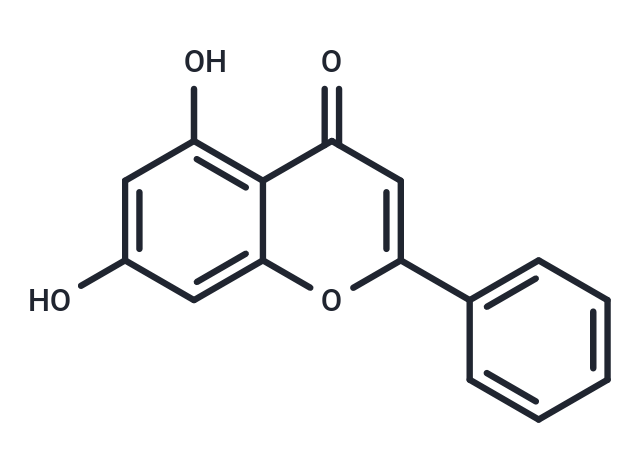Shopping Cart
- Remove All
 Your shopping cart is currently empty
Your shopping cart is currently empty

Chrysin (5,7-Dihydroxyflavone) exhibits many biological activities and pharmacological effects, including antioxidant, anti-inflammatory, anticancer, and antiviral activities.

| Pack Size | Price | Availability | Quantity |
|---|---|---|---|
| 500 mg | $42 | In Stock | |
| 1 g | $50 | In Stock | |
| 1 mL x 10 mM (in DMSO) | $46 | In Stock |
| Description | Chrysin (5,7-Dihydroxyflavone) exhibits many biological activities and pharmacological effects, including antioxidant, anti-inflammatory, anticancer, and antiviral activities. |
| Alias | NSC 407436, 5,7-Dihydroxyflavone, 5, 7-Dihydroxyflavone |
| Molecular Weight | 254.24 |
| Formula | C15H10O4 |
| Cas No. | 480-40-0 |
| Smiles | OC1=CC(O)=C2C(=O)C=C(OC2=C1)C1=CC=CC=C1 |
| Relative Density. | 1.2693 g/cm3 (Estimated) |
| Storage | Powder: -20°C for 3 years | In solvent: -80°C for 1 year | Shipping with blue ice. | |||||||||||||||||||||||||||||||||||
| Solubility Information | Ethanol: < 1 mg/mL (insoluble or slightly soluble) H2O: < 1 mg/mL (insoluble or slightly soluble) DMSO: 55 mg/mL (216.33 mM), Sonication is recommended. | |||||||||||||||||||||||||||||||||||
Solution Preparation Table | ||||||||||||||||||||||||||||||||||||
DMSO
| ||||||||||||||||||||||||||||||||||||

Copyright © 2015-2025 TargetMol Chemicals Inc. All Rights Reserved.